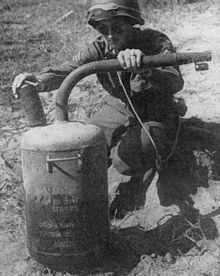Abwehrflammenwerfer 42
This article includes a improve this article by introducing more precise citations. (November 2014) ) |

The Abwehrflammenwerfer 42 was a German static defensive
The mine consisted of a large fuel cylinder 53 centimetres (21 in) high and 30 centimetres (12 in) with a capacity of 29.5 litres (6.5 imp gal; 7.8 US gal) containing a black viscid liquid; a mix of light, medium, and heavy oils. A second, smaller cylinder, 67 millimetres (2.6 in) in diameter and 25 centimetres (9.8 in) high, was mounted on top of the fuel cylinder; it contained the propellant powder, which was normally either
When the mine was triggered, a squib charge ignited the propellant, creating a burst of hot gas which forced the fuel from the main cylinder and out of the flame tube. A second squib ignited the fuel as it passed out of the end of the tube. The projected stream of burning fuel was 4.5 metres (15 ft) wide and 2.7 metres (8 ft 10 in) high with a range of about 27 metres (89 ft), and lasted about 1.5 seconds.
References
- TM-E 30-451, Handbook on German Military Forces, War Department
- Flamethrowers of the German Army 1914-1945 by Fred Koch
- Westwood, David (2005). German Infantryman (3) Eastern Front 1943-45. Warrior. Osprey Publishing. ISBN 978-1-84176-780-2.
- ""Fougasse Flame Throwers" from Intelligence Bulletin, November 1944". lonesentry.com. Retrieved 3 August 2010.
See also
